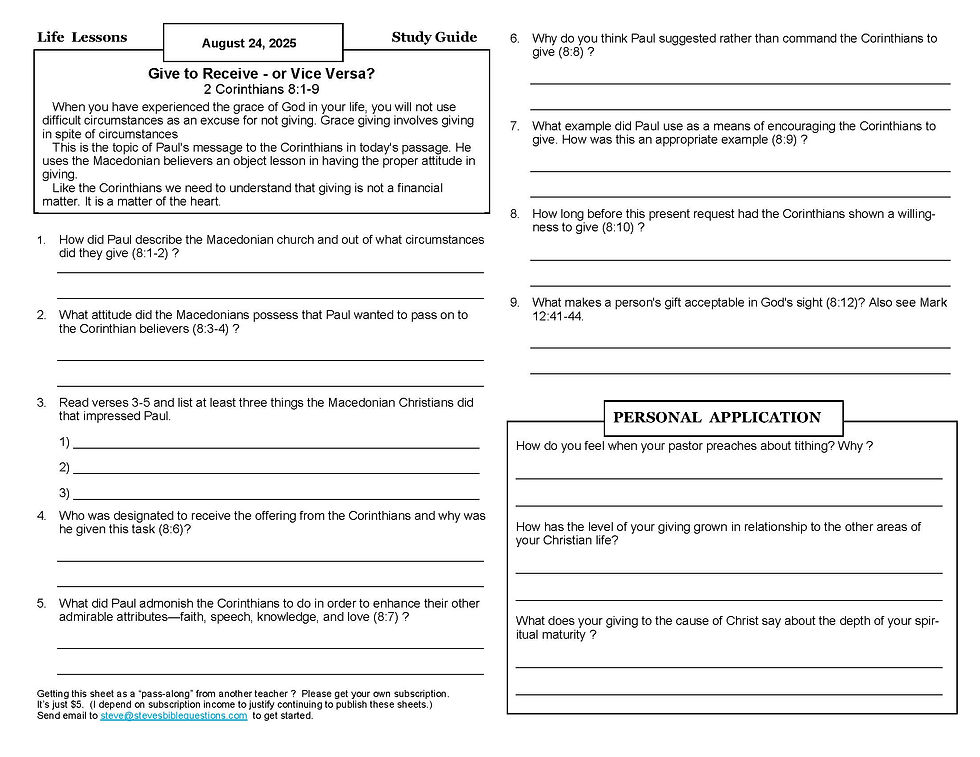A Simple Leader Checklist That Multiplies Teacher Effectiveness
- steveguidry
- Aug 6
- 2 min read
Updated: Aug 9
The Effectiveness of a Checklist Compared to Further Training
It's a common scenario: passionate teachers who are keen to make a difference but may occasionally fall short in terms of lesson planning, classroom engagement, or follow-up. This isn't due to a lack of dedication but rather the challenge of remembering everything amidst the busy schedule of church life. Even experienced teachers find value in having a straightforward framework to enhance their effectiveness.
This is where a thoughtfully crafted checklist can significantly benefit your teachers. It doesn't serve as a substitute for training or supervision but rather acts as a reinforcement. Picture it as a pre-flight checklist for your Bible educators. It doesn't need to be extensive or intricate. In fact, the shorter and more direct, the more effective it is. The aim is to keep essential ministry priorities at the forefront for your leaders consistently.
What Should the Checklist Include?
A well-designed checklist aids teachers in:
- Focusing on spiritual readiness
- Cultivating relationships
- Emphasizing discussion and interaction
- Maintaining communication with both you and their students
Here's a sample weekly leader checklist that you can tailor for your teachers:
Weekly Teacher Checklist:
- Dedicate time for individual prayer for each student.
- Study the Bible passage thoroughly before anything else.
- Determine the core message or spiritual lesson for the upcoming class.
- Draft 3 - 5 thought-provoking questions for reflection and dialogue. Alternatively, use provided questions.
- Personally reach out to a class member (via call, text, or email).
- Prepare a compelling introduction (anecdote, query, or attention grabber).
- Review supplementary materials (commentaries, workbooks, worksheets).
- Arrive early, pray over the space, and greet attendees warmly.
The objective is consistency, not flawlessness.
Implementing the Checklist Without Adding Pressure
Introduce the checklist as a supportive tool rather than an additional burden. Integrate it into your existing routines:
- Print it as a bookmark for teacher resources.
- Include it in your weekly correspondence with teachers.
- Discuss it during training sessions with practical illustrations.
- Encourage teachers to adapt it to suit their preferences. Some may create their version, while others might add checkboxes to their lesson planners. The focus is not on uniformity but on reinforcement.
Why Does It Work?
A checklist is effective as it:
- Keeps essential tasks visible
- Cultivates positive teaching habits
- Guides new teachers on effective preparation
- Instills confidence and peace of mind
The goal is for your teachers to enter sessions spiritually prepared, equipped, and attentive to individuals rather than just the curriculum. A weekly checklist gently steers them in this direction without the need for extensive meetings.
With time, teachers will internalize the process: Pray. Prepare. Connect. Teach.
Aligning with a Greater Purpose
As teachers embrace the checklist, emphasize that each item is more than a task; it represents a ministry opportunity:
- Prayer fosters empathy.
- Crafting questions initiates spiritual dialogues.
- Reaching out to members strengthens bonds.
- Early arrival sets a welcoming atmosphere.
These elements are not mere checkboxes but practices that foster a nurturing and evolving environment in your adult classes.




Comments